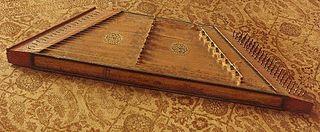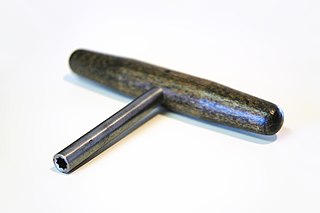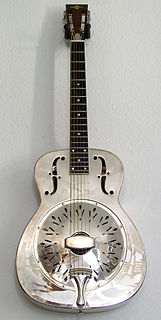Related Research Articles
The banjo is a stringed instrument with a thin membrane stretched over a frame or cavity to form a resonator. The membrane is typically circular, and usually made of plastic, or occasionally animal skin. Early forms of the instrument were fashioned by African Americans in the United States. The banjo is frequently associated with folk and country music, and has also been used in some rock, pop and hip-hop. Several rock bands, such as the Eagles, Led Zeppelin, and The Allman Brothers, have used the five-string banjo in some of their songs. Historically, the banjo occupied a central place in Black American traditional music and the folk culture of rural whites before entering the mainstream via the minstrel shows of the 19th century. Along with the fiddle, the banjo is a mainstay of American styles of music, such as Bluegrass and old-time music. It is also very frequently used in traditional ("trad") jazz. Banjo is also a common instrument for Caribbean genres like Biguine, Calypso and Mento.

The word dulcimer refers to two types of musical string instruments.

The hammered dulcimer is a percussion-stringed instrument which consists of strings typically stretched over a trapezoidal resonant sound board. The hammered dulcimer is set before the musician, who in more traditional styles may sit cross-legged on the floor, or in a more modern style may stand or sit at a wooden support with legs. The player holds a small spoon-shaped mallet hammer in each hand to strike the strings. The Graeco-Roman dulcimer derives from the Latin dulcis (sweet) and the Greek melos (song). The dulcimer, in which the strings are beaten with small hammers, originated from the psaltery, in which the strings are plucked.

String instruments, stringed instruments, or chordophones are musical instruments that produce sound from vibrating strings when a performer plays or sounds the strings in some manner.

Zither is a class of stringed instruments. Historically, the name has been applied to any instrument of the psaltery family, or to an instrument consisting of many strings stretched across a thin, flat body. This article describes the latter variety.

Old-time music is a genre of North American folk music. It developed along with various North American folk dances, such as square dancing, clogging, and buck dancing. It is played on acoustic instruments, generally centering on a combination of fiddle and plucked string instruments, most often the banjo, guitar, and mandolin. The genre is considered a precursor to modern country music.

The Appalachian dulcimer is a fretted string instrument of the lute family, typically with three or four strings, originally played in the Appalachian region of the United States. The body extends the length of the fingerboard, and its fretting is generally diatonic.

The trapezoidal yangqin is a Chinese hammered dulcimer, likely derived from the Iranian santur or the European dulcimer. It used to be written with the characters 洋琴, but over time the first character changed to 揚, which means "acclaimed". It is also spelled yang quin or yang ch'in. Hammered dulcimers of various types are now very popular not only in China, but also Eastern Europe, the Middle East, India, Iran, and Pakistan. The instruments are also sometimes known by the names "santoor" and "cymbalom". This instrument had an influence on the Thai classical instrument, known as Khim (ขิม).

Jacques Dudon is a French just intonation composer and instrument builder. He is best known for developing a series of photosonic disk instruments in the 1980s that produced sound from modulated light.

The tenor guitar or four-string guitar is a slightly smaller, four-string relative of the steel-string acoustic guitar or electric guitar. The instrument was initially developed in its acoustic form by Gibson and C.F. Martin so that players of the four-string tenor banjo could double on guitar.

Appalachian music is the music of the region of Appalachia in the Eastern United States. Traditional Appalachian music is derived from various influences, including the ballads, hymns and fiddle music of the British Isles, the African music and blues of early African Americans, and to a lesser extent the music of Continental Europe.

The qinqin is a plucked Chinese lute. It was originally manufactured with a wooden body, a slender fretted neck, and three strings.photo 1[ photo 2] Its body can be round,photo hexagonal, or octagonal.[ photo] Often, only two strings were used, as in certain regional silk-and-bamboo ensembles.photo In its hexagonal form, it is also referred to as meihuaqin.

The mandolin-banjo is a hybrid instrument, combining a banjo body with the neck and tuning of a mandolin or violin. It is a soprano banjo. It has been independently invented in more than one country, being called banjolin and banjourine in English-speaking countries, banjoline and bandoline in France, and the Cümbüş in Turkey.

A tuning wrench is a specialized socket wrench used to tune string instruments, such as the piano, harp, and hammer dulcimer, that have strings wrapped around tuning pins. Other string instruments do not require a tuning wrench because their tuning pins or pegs come with handles, or geared tuning machines.

A resonator guitar or resophonic guitar is an acoustic guitar that produces sound by conducting string vibrations through the bridge to one or more spun metal cones (resonators), instead of to the guitar's sounding board (top). Resonator guitars were originally designed to be louder than regular acoustic guitars, which were overwhelmed by horns and percussion instruments in dance orchestras. They became prized for their distinctive tone, however, and found life with bluegrass music and the blues well after electric amplification solved the problem of inadequate volume.
Homer C. Ledford was an instrument maker and bluegrass musician from Kentucky who specialized in making dulcimers.

Acoustic Christmas Carols: Cowboy Christmas II is the twenty-second album by American singer-songwriter Michael Martin Murphey and his second album of Christmas music. Recorded at St. James Episcopal Church in Taos, New Mexico, the church Murphey attended at the time, the album consists of carols from the nineteenth century or earlier played on acoustic instruments, among them "Silent Night" and "Joy to the World". Murphey's arrangements feature his own finger-picked guitar, accompanied by John McEuen on banjo or mandolin, or Paul Sadler on hammer dulcimer. Murphey's sons, Ryan and Brennan, play blues guitar licks on "Go Tell It on the Mountain", and his daughter, Laura, sings a duet with her father on "Silent Night". This is a "spare and reverent Christmas album, appropriate for a rustic celebration in a Western church."
The resonator dulcimer is an Appalachian dulcimer which features a metal resonating cone inset in the body, which receives and acoustically amplifies the vibration of the strings. The first instrument was conceived in 1977 and completed in 1979 by dulcimer luthier Homer Ledford, who called it a "dulcibro".
The dulcitar is a variant of the Appalachian dulcimer, which retains the dulcimer's diatonic fret layout yet features a long neck that is intended to be played upright in the guitar style rather than flat across the lap. Luthier Homer Ledford coined the word dulcitar as a portmanteau of dulcimer and guitar, building his first model of the instrument around 1971. One of Ledford's dulcitars was accepted into the permanent collection of the Smithsonian Institution, as well as displayed in a traveling exhibit on American craftsmanship.
Weymann Guitars is an American manufacturing company of musical instruments. Established in 1864 in Philadelphia, Weymann is one of the oldest instrument companies in the country. Originally founded as "H. A. Weymann and Son" by German immigrant Henry Arnold Weymann, Weymann patented the mandolute and also developed the first "Jumbo" body acoustic guitar produced during the turn of the century, nearly two decades before competitors in the instrument industry.
References
- ↑ Alvey, R. Gerald. Dulcimer Maker: the craft of Homer Ledford. University Press of Kentucky, 2003. ISBN 978-0-8131-9051-8